A patient's suicide is an occupational hazard for psychiatrists, one that leaves a torrent of personal and professional aftershocks, said Eric M. Plakun, M.D.
Other medical specialists face the death of their patients, but the self-inflicted death of a psychiatric patient may differ in its effect on the treating physician because of the different nature of the doctor-patient relationship, said Plakun, director of admissions and professional relations at the Austen Riggs Center in Stockbridge, Mass. He spoke last month at the 48th winter meeting of the American Academy of Psychoanalysis and Dynamic Psychiatry in Washington, D.C. “It makes us wonder why we didn't go into ophthalmology.”
Suicide accounts for more than 30,000 deaths a year in the United States. Its incidence may well be underreported, given the stigma and possible insurance problems associated with it. Psychiatric disorders like alcoholism, schizophrenia, borderline personality disorders, and major depressive episodes are risk factors for suicide. Moreover, many people who commit suicide are often already being treated by a psychiatrist or mental health professional.
Perhaps half of all psychiatrists can expect a patient to commit suicide during their careers. And 1 in 6 psychology interns and 1 in 3 psychiatry residents have experienced a patient's suicide during training, said Plakun. Higher rates in training probably occur because junior residents are often assigned to vulnerable populations in emergency or inpatient settings.
“There are three kinds of psychiatrists: those who have had a patient commit suicide, those who will have one commit suicide, and those with both,” said forensic psychiatrist Robert I. Simon, M.D., a clinical professor of psychiatry at Georgetown University Medical School and chair of the psychiatry department at Suburban Hospital in Bethesda, Md. “If you practice long enough, someone will commit suicide. It's inevitable.”
Research reveals that the event is neither simple nor shortlived.
For instance, one-quarter of 239 responding graduates of a University of Toronto residency program said that experiencing a patient's suicide had a“ profound and enduring effect on them throughout their careers as physicians.” Plakun likens the experience to hovering on the edge of a crime scene.
“If a psychiatric patient suicides, a murder is committed, and the murderer is our patient with whom we have had an empathic relationship,” said Plakun.
Jane Tillman, Ph.D., a staff psychologist and manager of performance improvement at Austen Riggs interviewed 12 therapists about the impact of patient suicide on their lives and careers. From this research, several common themes have emerged, reported Plakun. Shock, numbing, anger, and grief assert themselves first, often followed by a sense of unreality, disconnection, or withdrawal. Some doctors have a hard time overcoming the feeling that“ it could never happen to them.” They may experience a sense of survivor's guilt in that the “murderer” has chosen to kill himself or herself rather than the therapist. They may feel overwhelmed by shame and humiliation at “failing” a patient.
Some psychiatrists may even endure a crisis of faith about their training and therapeutic work. They may switch to a purely psychopharmacological approach to minimize the personal connection with patients. Others decide not to work with overtly suicidal patients. Fear of litigation is a natural consequence as well. Relationships with colleagues may suffer if therapists feel stigmatized as incompetent or worse by their peers.
However, if psychiatrists are only a flip of the coin away from having a patient commit suicide, perhaps the profession should build preparation for dealing with it into the residency curriculum, argued Plakun.
Simon, author of Suicide Risk, published in 2004 by American Psychiatric Publishing Inc., advised new residents: “Be sure you learn how to do a competent, systematic, suicide-risk assessment.”
Besides assessing and treating suicidal patients, training should include lectures and role playing to improve young clinicians' understanding of the aftermath of suicidal events, added Plakun.
Once a suicide occurs, Plakun advised clinicians to seek consultation and support and to avoid isolation. “Recognize that you won't be able to think clearly about it for a while,” he said. “Too often therapists deal with this in isolation rather than risk difficulties with colleagues. It's hard to talk about it with them.”
A formal discussion of the patient's death will be covered by a JCAHO sentinel event review if an institution is involved. More than the usual morbidity and mortality conference is needed, however. Plakun also recommended that clinicians find a “secure, peer-reviewed, protected space” to consider the event as a traumatic experience affecting both the therapist and the entire staff.
Legal requirements vary from state to state, but Plakun and Simon advised consulting with insurance carriers or attorneys regarding subsequent actions.
Finally, the clinician should prepare for contact with the patient's family, said Plakun. He advised meeting them in person after giving some thought on how to manage issues of confidentiality.
“Lawyers tell you not to make any statements, but a professional must understand what makes the family feel good or bad,” said Simon.“ The balance between maintaining patient confidentiality and responding openly and empathically to surviving family members' questions and feelings can be a daunting task for the clinician.”
“The prime motive for meeting with the family is to meet their needs, not your own,” added Plakun. “Offer them a blame-free, nonjudgmental, nondefensive time to recognize their grief, guilt, anger, and blame.”
Nevertheless, psychiatrists must take the steps needed to maintain their professional and personal equilibrium while understanding that the aftereffects may linger.
“Clinicians who lose patients to suicide are not ordinarily considered suicide survivors; however, they usually carry a lifelong emotional burden” said Simon.
Information on contacting family after a patient's suicide is included in APA's practice guideline on suicidal behavior. The guideline is posted at<www.psych.org/psych_pract/treatg/pg/Practice%20Guidelines8904/SuicidalBehaviors.pdf>.▪

